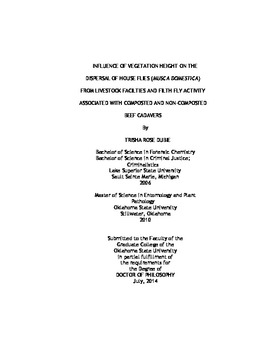| dc.contributor.advisor | Talley, Justin | |
| dc.contributor.author | Dubie, Trisha Rose | |
| dc.date.accessioned | 2015-06-17T20:05:37Z | |
| dc.date.available | 2015-06-17T20:05:37Z | |
| dc.date.issued | 2014-07 | |
| dc.identifier.uri | https://hdl.handle.net/11244/14810 | |
| dc.description.abstract | House flies, Musca domestica L., are well known pests inexorably linked to livestock operations, and they also serve as mechanical vectors of various human pathogens including E. coli 0157:H7. Changes in the landscape from anthropogenic activity have resulted in increased human exposure to house fly pests, and monitoring their movements is paramount in assessing the risks associated with flies emigrating from livestock facilities. This study focused on edge following behavior and the use of habitat corridors by house flies. Artificial structures designed to represent tree and shrub lines were constructed in a field south of a beef feedlot facility. Marked house flies were released at individual sites containing 3m walls, 1.5m walls and a control site with no wall and a substantially higher number of flies were trapped at the 3m site than both the control and 1.5m sites. Immunomarking techniques were also evaluated for this study using chicken ovalbumin as an antigen. A false negative rate of 0% was determined using unmarked wild flies as negative controls. Livestock facilities are also faced with the challenge of disposing of a significant number of cadavers each year. One increasingly popular way of dealing with dead animals is composting. Animal mortality compost is designed to facilitate decomposition without the aid of carrion feeding insects and reduce the presence of common pathogens associated with animal waste and dead tissue. The goal of this study was to evaluate insect activity associated with composted and exposed beef cadavers, specifically filth flies that can serve as mechanical vectors of important human pathogens such as E. coli 0157:H7. The number of filth flies was significantly lower at the composted site than the exposed site. Volatile organic compounds were also sampled in this study, and known fly attractants such as dimethyl disulfide were inhibited by the composting process. Lastly, carrion feeding insects were collected from each of the exposed animals and documented. These species are also important in forensic entomology. Implementing composting programs and using walls of vegetation at livestock facilities could reduce the risk of flies spreading harmful pathogens to surrounding areas including farms that grow fresh produce. | |
| dc.format | application/pdf | |
| dc.language | en_US | |
| dc.rights | Copyright is held by the author who has granted the Oklahoma State University Library the non-exclusive right to share this material in its institutional repository. Contact Digital Library Services at lib-dls@okstate.edu or 405-744-9161 for the permission policy on the use, reproduction or distribution of this material. | |
| dc.title | Influence of vegetation height on the dispersal of house flies (Musca domestica) from livestock facilities and filth fly activity associated with composted and non-composted beef cadavers | |
| dc.contributor.committeeMember | Royer, Tom | |
| dc.contributor.committeeMember | Wayadande, Astri | |
| dc.contributor.committeeMember | Richards, Chris | |
| dc.contributor.committeeMember | Payne, Joshua | |
| osu.filename | Dubie_okstate_0664D_11016.pdf | |
| osu.accesstype | Open Access | |
| dc.type.genre | Dissertation | |
| dc.type.material | Text | |
| dc.subject.keywords | carrion | |
| dc.subject.keywords | composting | |
| dc.subject.keywords | dispersal | |
| dc.subject.keywords | house flies | |
| dc.subject.keywords | immunomarking | |
| dc.subject.keywords | musca domestica | |
| thesis.degree.discipline | Entomology | |
| thesis.degree.grantor | Oklahoma State University | |
